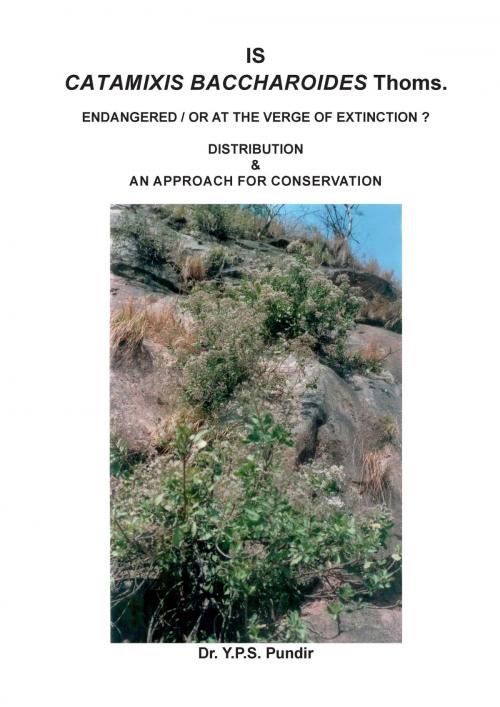CATAMIXIS BACCHAROIDES
Nonfiction, Science & Nature, Nature, Environment, Environmental Conservation & Protection| Author: | Dr. Y.P.S. Pundir | ISBN: | 1230000482547 |
| Publisher: | Creative Grove | Publication: | June 12, 2015 |
| Imprint: | Language: | English |
| Author: | Dr. Y.P.S. Pundir |
| ISBN: | 1230000482547 |
| Publisher: | Creative Grove |
| Publication: | June 12, 2015 |
| Imprint: | |
| Language: | English |
For the first time in human history, in recent years Western HIMALAYAN BIODIVERSITY as a whole is endangered and more than 10% species of the flowering plants of this region are threatened due to modern man’s intervention with the environment in the name of development, industrialization, urbanization, rehabilitation etc. In addition to this, to meet the increasing demand of the modern civilized population of the plains for raw plant materials a large number of forest species are over-exploited and many of them are now threatened. Secondly, increasing human population with time in the Himalayan hills and also the increasing population of their cattle and goats have also exerted great biotic pressure, which is increasing day by day on the forest cover, and this has further strengthen the threat.
Although WESTERN HIMALAYAN BIODIVERSITY, as a whole, is threatened, DOON VALLEY, one of the largest valley in the world, is facing the worst situation. This valley, due to its natural boundaries within which it is enclosed – the Himalayan mountains (Mussoorie hills) in the north and Siwalik hills in the south, which are always in view, and on its two sides being bounded by two most important and holy rivers Ganga (Ganges) and Jamuna (Yamuna), is considered among the most beautiful valleys in the world. Moreover, it is also famous from prehistoric days for its natural heritage and valuable plant wealth with a very rich and diversified flora with more than 1600 species of the flowering plants, which include both tropical and temperate elements. The species are significant from the scientific, cultural, and utilization viewpoints as they grow in a wide range of habitats (marshes, swamps, humid shady places and on extremely dry parts of steep ridges and hills), which provided great ecological diversity. In brief, a very few areas in India can claim to have such a diversified range of plants of indigenous and exotic origin as Dehradun, Saharanpur-Siwaliks and Mussoorie hills (Western Himalayas).
Unfortunately, biodiversity of this region of Western Himalaya as a whole is endangered. In other words, a biodiversity crisis has developed in last few decades because in past 40 year, an appreciable part of Doon Valley land has been cleaned for rehabilitation, urbanization and industrialization, and a large number of species have been extracted in most unplanned manner resulting in a sudden fall in their population. Thus some time back, the seriousness of the problem forced the environmentalists to declare this region as ecological fragile.
Thus realizing the need of time, in past 3-4 decades HIMALAYAN BIODIVERSITY has been the subject of much discussion in seminars and conferences, which gave birth to voluminous writings. Unfortunately, all these discussions and suggestions on plant diversity remained on paper. So far, concerted practical attempts have not been made in any part of Western Himalayas to conserve the endemic, endangered and non-commercial rare wild plant species in situ and ex situ. Therefore, many species have reached in the danger zone of extinction or have disappeared from the flora of the region.
Thus realizing the urgent need of time, the work to conserve some non-commercial forest wild species, was taken some time back in 1997-2001. As far as I am aware, this was the first work of its kind on Western Himalayan Biodiversity, which aimed to conserve, in real sense, in situ as well as ex situ some non-commercial but endangered, and rare wild plant species of Doon Valley, Saharanpur-Siwaliks and lower Mussoorie hills.Catamixis baccharoides Thoms, which is endemic in a very small part of Uttarakhand hills (Western Himalayas) in Haridwar and Saharanpur Siwalik hills in India is detailed here. The book with more than 50 color photographs and distribution maps is prepared to high light (A to Z) known facts about this disappearing species, cited below.
For the first time in human history, in recent years Western HIMALAYAN BIODIVERSITY as a whole is endangered and more than 10% species of the flowering plants of this region are threatened due to modern man’s intervention with the environment in the name of development, industrialization, urbanization, rehabilitation etc. In addition to this, to meet the increasing demand of the modern civilized population of the plains for raw plant materials a large number of forest species are over-exploited and many of them are now threatened. Secondly, increasing human population with time in the Himalayan hills and also the increasing population of their cattle and goats have also exerted great biotic pressure, which is increasing day by day on the forest cover, and this has further strengthen the threat.
Although WESTERN HIMALAYAN BIODIVERSITY, as a whole, is threatened, DOON VALLEY, one of the largest valley in the world, is facing the worst situation. This valley, due to its natural boundaries within which it is enclosed – the Himalayan mountains (Mussoorie hills) in the north and Siwalik hills in the south, which are always in view, and on its two sides being bounded by two most important and holy rivers Ganga (Ganges) and Jamuna (Yamuna), is considered among the most beautiful valleys in the world. Moreover, it is also famous from prehistoric days for its natural heritage and valuable plant wealth with a very rich and diversified flora with more than 1600 species of the flowering plants, which include both tropical and temperate elements. The species are significant from the scientific, cultural, and utilization viewpoints as they grow in a wide range of habitats (marshes, swamps, humid shady places and on extremely dry parts of steep ridges and hills), which provided great ecological diversity. In brief, a very few areas in India can claim to have such a diversified range of plants of indigenous and exotic origin as Dehradun, Saharanpur-Siwaliks and Mussoorie hills (Western Himalayas).
Unfortunately, biodiversity of this region of Western Himalaya as a whole is endangered. In other words, a biodiversity crisis has developed in last few decades because in past 40 year, an appreciable part of Doon Valley land has been cleaned for rehabilitation, urbanization and industrialization, and a large number of species have been extracted in most unplanned manner resulting in a sudden fall in their population. Thus some time back, the seriousness of the problem forced the environmentalists to declare this region as ecological fragile.
Thus realizing the need of time, in past 3-4 decades HIMALAYAN BIODIVERSITY has been the subject of much discussion in seminars and conferences, which gave birth to voluminous writings. Unfortunately, all these discussions and suggestions on plant diversity remained on paper. So far, concerted practical attempts have not been made in any part of Western Himalayas to conserve the endemic, endangered and non-commercial rare wild plant species in situ and ex situ. Therefore, many species have reached in the danger zone of extinction or have disappeared from the flora of the region.
Thus realizing the urgent need of time, the work to conserve some non-commercial forest wild species, was taken some time back in 1997-2001. As far as I am aware, this was the first work of its kind on Western Himalayan Biodiversity, which aimed to conserve, in real sense, in situ as well as ex situ some non-commercial but endangered, and rare wild plant species of Doon Valley, Saharanpur-Siwaliks and lower Mussoorie hills.Catamixis baccharoides Thoms, which is endemic in a very small part of Uttarakhand hills (Western Himalayas) in Haridwar and Saharanpur Siwalik hills in India is detailed here. The book with more than 50 color photographs and distribution maps is prepared to high light (A to Z) known facts about this disappearing species, cited below.















